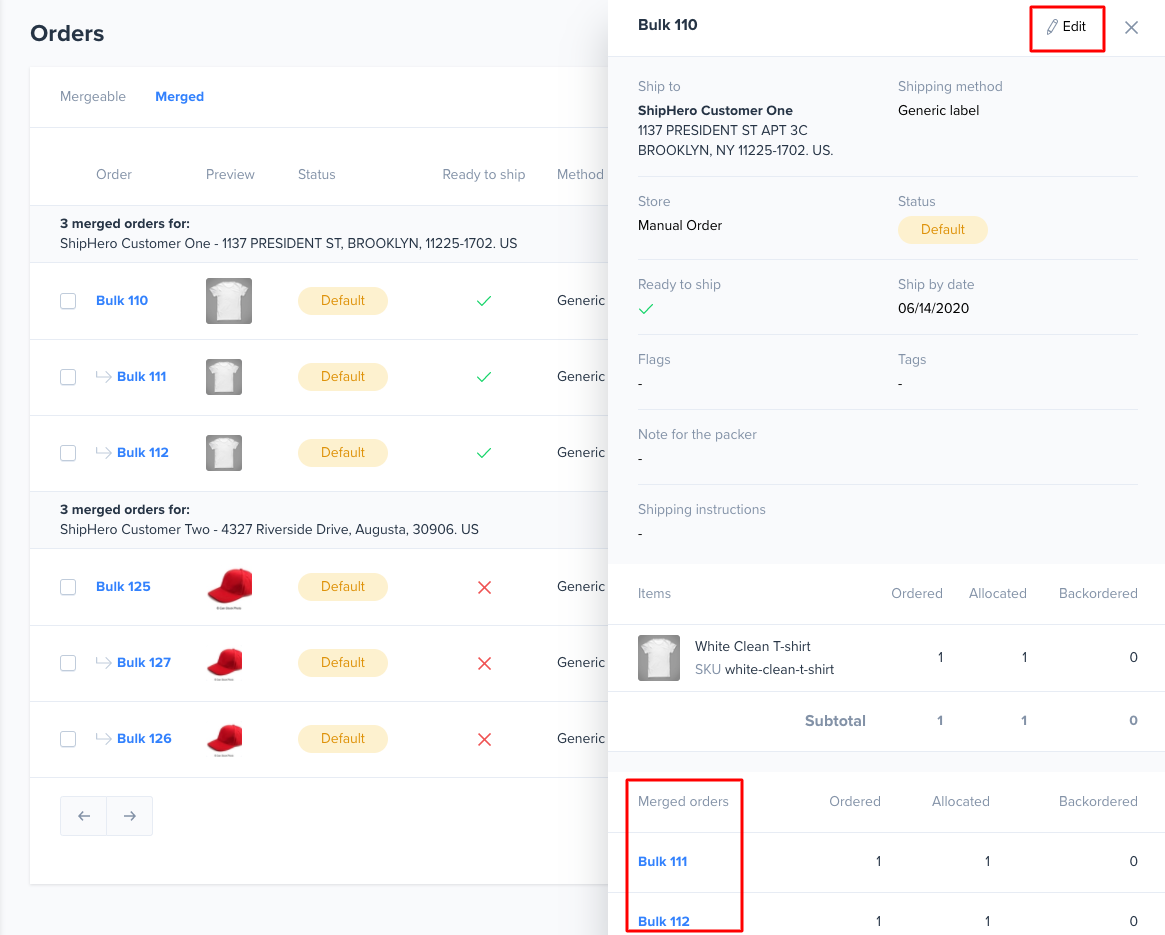How to Merge Orders
Users can identify mergeable orders by routing to shipping.shiphero.com (or clicking on the blue Pack & Ship Orders button in app.shiphero.com if you have already migrated to the new UI), then selecting Orders and clicking the Mergeable tab.
 The mergeable orders table lists orders grouped by merging rules, specified in the settings page at the top right on the page. By default, merging rules will only group orders which have the same Customer Name AND Shipping Address.
The mergeable orders table lists orders grouped by merging rules, specified in the settings page at the top right on the page. By default, merging rules will only group orders which have the same Customer Name AND Shipping Address.
Each order group is separated by a group header specifying the quantity of potential mergeable orders in that group and a few details such as the customer's name and the address. All orders inside each group could potentially be merged into a single order. Orders from different groups cannot be merged.
To prevent multiple shipments of a merged order, the following orders will NOT be able to be merged:
- Orders with Allow Partial enabled
- Orders that are locked in a tote
- Orders that are 3 weeks old or more
Step 1: Select Which Orders to Merge
Select two or more orders in a group by clicking on the left-side checkbox of any order row. Once two or more mergeable orders have been selected, a master order needs to be specified. Master orders are a way for ShipHero to know which order should display details in the packer/picker process.

Step 2: Indicate a Master Order
Once two or more orders from the same group are selected, a radio button on the last column to the right will be enabled. This allows the user to change the master order.

Master Order selection rules:
- Only a selected order can be a master order.
- If an order is not selected, the radio button is disabled.
- If there is only one order selected, that is the master order. By default, the master order is the first order to be selected.
- If a master order is deselected, and there are other orders selected in the group, the one with the oldest creation date becomes the master.
Step 3: Merge Orders
After selecting two or more orders and indicating a master order, hit the Merge button in the upper section of the table to merge the orders.

When an order group already has merged orders from a previous merging process, the master order of this group cannot be changed and will show a collapse/uncollapse arrow at the end of its row.
When clicking the arrow, the row will uncollapse the already merged orders in the group, showing them as subrows of lesser size, with a small arrow icon at the beginning of the subrow.

How to View Orders Already Merged
Merged orders will be listed in the Merged tab, similar to mergeable orders. The table component will be the same, but with some restrictions.
- The master order radio button will always be disabled.
- Any order can be selected to be un-merged from its current master order.
- If the user selects a master order to be un-merged, all of the remaining orders of the same group will be un-merged as well.

Collapsed vs. Uncollapsed Merged Orders
Merged orders are displayed as subrows of each master order. By default, the master order will always be uncollapsed so that merged orders are visible. You can collapse merged orders by clicking on the arrow on the right side of the order.

Unmerging Orders
Users can unmerge orders by clicking the master order (which will select all orders under it) and selecting Unmerge at the top of the page. This will un-merge all selected orders, remove them from the Merged orders table, and move them to the Mergeable orders table, assuming that the orders still match the merging rules defined in settings.

Order Details Drawer
Clicking on any order row will toggle an info drawer with details of the order. The drawer provides users with a quick glance of the order details and will also inform the user if the order has already been merged to a specific master order. Clicking Edit at the top of the page will navigate the user to the order details page on app.shiphero.com.

Master Order View

Setting up Merging Rules
Merging rules can be defined by clicking on the Edit Merging Rules button on the top right of the page or by going to endeavour.shiphero.com > (your profile picture) > Settings. Merging rules are used to define the criteria for Mergeable Groups on the mergeable orders table and can be customized. There are two types of rules that can be specified: Grouper Rules and Dismisser Rules.
Grouper Rules
Orders will show up as mergeable if ALL defined characteristics match. Mandatory characteristics include the customer name and complete shipping address. Users have the option to group orders based on additional characteristics as follows:
- store
- shipping method
- short shipment terms
- status
- order options
- required ship date
- priority
Dismisser Rules
Orders will not show up as mergeable if they have ANY of the defined characteristics. Mandatory characteristics include orders that are flagged for dropshipping, locked in a tote, have Allow Partial flagged, on hold, canceled, or fulfilled. Users have the option to dismiss orders based on additional characteristics as follows:
- backorder
- partial ship
- priority
- status
- SKU
- tags
